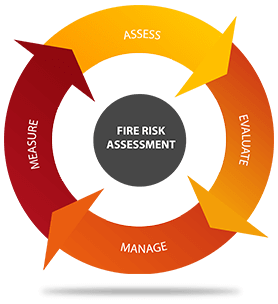
The OSHA requirements for an emergency action plan form a useful guide for the creation of fire safety procedures.
Fire safety procedures are a written set of plans describing the actions to be taken in the event of a fire emergency, and assigning responsibility for each action. Each set of plans needs to be customized; the recommended actions and responsibilities will be different depending on the facility, the type of work being done there, the types of materials used, and the people present.
The first step in creating fire safety procedures is to conduct a Fire Risk Assessment. It is impossible to make an effective and comprehensive plan without the necessary information; an assessment will provide the details that you need.
Here's a look at what a risk assessment should cover:

Identification of hazards: E.g. waste and combustible material being stored on-site, flammable liquids and vapours, objects that generate heat, and electrical equipment.
Sources of ignition: E.g. combustible materials such as wood, paper, trash and clothing; flammable liquids such as gasoline or solvents; and flammable gases such as propane or natural gas.
Identification of persons at risk from fire: You must look at where the employees are working. Also, consider who else may be at risk, e.g. customers and visitors, and where they're likely to be found. Anyone who is unfamiliar with the premises (such as new staff, contractors, and customers)
Means of escape from the building: Escape routes.
Fire warning systems: A fire alarm system has a number of devices working together to detect and warn people through visual and audio appliances when smoke, fire, or carbon monoxide (CO - is found in fumes produced any time you burn fuel in cars or trucks, small engines, stoves) or other emergencies present. Fire alarm warning devices can also be set to different volume levels.
Fire-fighting facilities: E.g. fire hydrants, hose reel systems, sprinkler systems, water mist and fogging systems, gas systems (sometimes referred to as “clean agent systems”) foam systems, and dry powder.
Review of the controls: In place and recommendations for improvements where necessary.
Fire safety training: Every workplace needs a defined training process to communicate the responsibilities and essential fire safety procedures to all employees. The best communication approach starts with training in the fire alarm systems, the evacuation routes to safely exit the building and the process of accounting for all personnel.